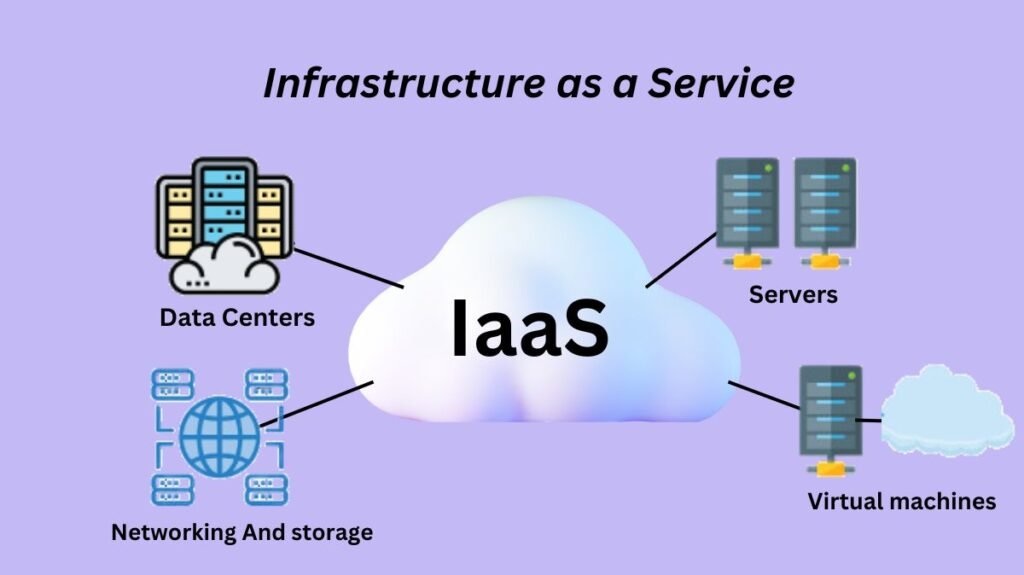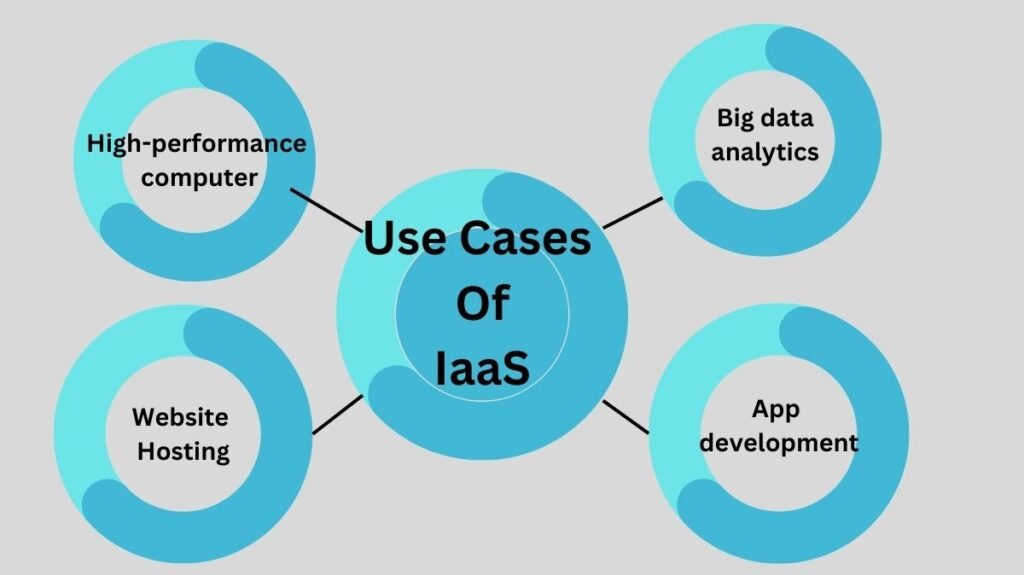What Is IaaS?
Infrastructures as a Service is sometimes referred to as Hardware as a Service (HaaS). It is among the Cloud Computing platform’s tiers. It enables users to contract out the use of servers, networking, computing, storage, virtual machines, and other IT infrastructures. Consumers employ a pay-per-use mechanism to access these resources online.
In classic hosting services, IT infrastructure with a predetermined hardware configuration was rented out for a certain amount of time. Regardless of the actual use, the customer paid for the time and configuration. Customers are only charged for the services they actually use, and they may dynamically expand the configuration to accommodate changing needs with the use of the IaaS cloud computing platform layer.
IaaS enables customers increase resources as needed, especially for “spiky” workloads, reducing the need for large upfront capital investments and the hassle of obtaining, deploying, and maintaining on-premises equipment.
Cloud Computing a study of infrastructure as a service IaaS
In 2006, Amazon Compute Cloud (EC2) virtualized computer resources, making IaaS widespread. Today, IaaS is the standard abstraction method for many workloads. IaaS is used by CSPs like Amazon Web Services (AWS). Google Cloud, Microsoft Azure, IBM Cloud, and Oracle Cloud handle servers, patches, and networking hardware. An organization can install, set up, and maintain software.
IaaS offers corporate flexibility, cost-effectiveness, reliability, and scalability. The IaaS sector is predicted to increase 33.50% from 2024 to 2031, reaching USD 562.53 billion (link outside of IBM.com).
Infrastructure as a Service Diagram

Why is Infrastructure as a Service important?
IaaS allows you to grow your computing power while spending less on IT. In the past, businesses bought and maintained their own computers in an on-site data center. However, in order to manage just sporadic high workloads, this frequently needed a significant upfront expenditure. For instance, during the holidays, an e-commerce business receives three times as much application traffic. They have to buy more server computers to manage this demand, yet they sit inactive for the remainder of the year.
IaaS providers keep a lot of hardware devices in extremely secure data centers to get around this problem. They provide you pay-as-you-go access to this cloud computing infrastructure. You have safe, adaptable access to nearly limitless resources to fulfill all of your legal, compliance, and commercial needs.
How does Infrastructure as a Service work?
The foundation of IaaS is virtualization. You may choose the kind and setup of the infrastructure you need from an IaaS provider. The underlying infrastructure is then automatically converted to digital form by the system. The behavior of these virtualized computer resources is similar to that of real resources. Everything functions the same for you and your apps as it would on a real device.
In order to facilitate infrastructure administration, IaaS providers often provide other services. You can utilize the services, for instance, to do the following tasks:
- Examine system logs and keep an eye on performance.
- Put uniform security measures in place for all of your infrastructure.
- Set up rules that automate routine infrastructure operations, such as load balancing and backup.
Infrastructure as a Service Examples
Examples of Infrastructure as a Service (IaaS) include the following:
- AWS, or Amazon Web Services: An established IaaS provider with customers in more than 20 regions and 190 nations.
- Azure by Microsoft: An IaaS that provides better software application management.
- One IaaS solution that some people find comfortable and straightforward to use is Google Cloud Platform.
- Alibaba Cloud: An IaaS company with operations in more than 200 nations.
- GCE, or Google Compute Engine: Google’s virtual machine IaaS product.
IaaS is a cloud computing architecture that uses the internet to deliver resources including storage, network, and processing power. It may be scaled up or down based on demand because it is a subscription service.
Which kinds of resources are included in Infrastructure as a Service?
Three major categories may be used to group infrastructure services.
Compute
The internal memory (RAM), graphics processing units (GPUs), and central processing units (CPUs) that computers need to complete any work are examples of cloud computing resources. In the form of cloud instances or virtual computers, users request computational resources. Following the supply of the necessary capacity by cloud services, you may carry out your scheduled duties in this virtual setting.
Network
Traditional networking hardware, such switches and routers, connects storage and computation into virtual machines by programmable assignment and organization. Virtual private clouds can be used in complex applications that span several different geographical locations.
Storage
Three kind of data storage resources are available from IaaS providers: Block storage, such a hard disk or SSD, stores data in blocks. Similar to a NAS, file storage keeps data as files. Data is stored in object storage as objects, much like in object-oriented programming.
Advantages of Infrastructure as a Service
Modern businesses can profit from the IaaS paradigm in the following ways:
Speed
You can test and bring new concepts to market much more quickly by provisioning an infinite number of resources in a matter of minutes. Because the IT infrastructure and computer resources are entirely managed by others, you may concentrate on your main business operations.
Performance
Scaling up your applications in places that are physically closer to your clients is possible with geographically dispersed data centers. If your server capacity and geographic reach are restricted, you might not be able to accomplish this on your own. You have a lot more alternatives with IaaS solutions to improve computing performance and lower network latency.
Dependability
IaaS providers provide a very dependable environment that enables the quick and predictable commissioning of replacement virtual machines.
Recovery and Backup
IaaS providers provide you with limitless disaster recovery and backup infrastructure. You may, for instance, copy your apps on many servers so that they will take over in the event of a server failure. In a similar vein, you may accomplish redundancy and business continuity by regularly and automatically syncing data backups.
Competitive Pricing
Networking, storage, and computation are essential to the majority of other services and can be employed as needed. By making cloud services accessible for small enterprises, customers will only pay for the resources they use, which encourages more effective IT resource management and fosters innovation.
Disadvantages of Infrastructure as a Service
Even while IaaS offers many benefits in terms of efficiency, flexibility, and reliability, there are some situations in which it might not be the best course of action.
Cost
Even though pay-as-you-go pricing has advantages, some companies are hesitant to invest in IT if they don’t have tangible assets to show for it. IaaS itemized billing and expenses may exceed expectations, particularly during brief surges of demand.
Control
Customers do not have the same level of visibility into daily administration, configuration, and performance information as they may be used to for assets under their direct control because service providers own the infrastructure.
Sovereignty
Cloud-based resources are restricted for companies who must retain physical custody and accountability over their data and computing resources.
What are the use cases of Infrastructure as a Service?

Infrastructure may be used to increase operational effectiveness and give solution delivery precedence over infrastructure management. An IaaS provider can help you enhance the client experience by providing you with completely managed, high-performing infrastructure. Let’s examine a few use case examples below.
High-performance computer
Solving physics and chemistry equations or analyzing vast amounts of data are examples of complex issues that demand a lot of processing power. Solving these issues on IaaS infrastructure rather than managing your own resources is more effective and economical.
Website Hosting
Infrastructure is used by businesses to host secure, scalable, and highly configurable web applications that satisfy their content delivery requirements. For instance, a variety of websites, from straightforward informational sites to intricate data delivery systems, may be created using web hosting.
Big data analytics
Businesses use data analysis to get meaningful insights and business intelligence. Data warehousing technology is a component of cloud architecture that allows for the integrated storage of massive amounts of data. An IaaS provider facilitates big data analytics by offering tools for better data management.
App development
You may simply build up distinct test and development environments using cloud infrastructure. New concepts can be tested and experimented with separately, or the team as a whole can use shared development environments.
IaaS Pricing
Like other public cloud services, IaaS needs a service level agreement (SLA) between a cloud service provider and a client that outlines what services the vendor will supply, the anticipated level of performance, how performance is assessed, and what happens if performance requirements are not reached.
IaaS is consumption-based, so customers pay for what they consume. The following are some more pricing strategies:
- Subscriptions and reserved instances: For customers who are prepared to commit to lengthier contract terms, usually ranging from one to three years, several providers provide reductions off the sticker price.
- Monthly billing: Since physical infrastructure usually suggests steady-state workloads devoid of spike features, monthly billing models are more prevalent with BMaaS than IaaS.
- The most popular granularity for traditional cloud infrastructure is by the hour or second, where customers are only billed for the actual amount of usage.
- Transient/spot: Some providers employ transient/spot instances to give away unneeded capacity at a reduced cost; nevertheless, such instances can be retrieved if more capacity is required.


[…] is linked to Infrastructure as a Service, Platform as a Service, and Software as a […]
[…] Cloud service providers make virtual or bare metal servers available to clients through the infrastructure-as-a-service (IaaS) […]
[…] The most common type of cloud server is a virtual machine (VM), also known as a compute instance, housed on a public cloud provider’s infrastructure and delivered to clients via a web-based console or interface. This paradigm is IaaS. […]